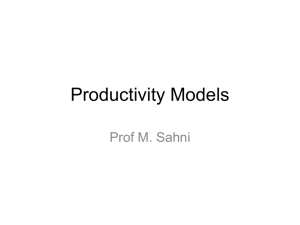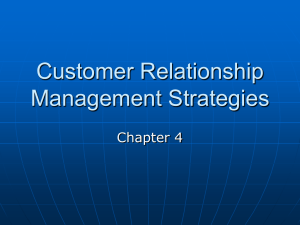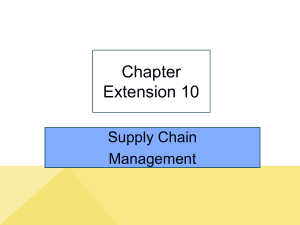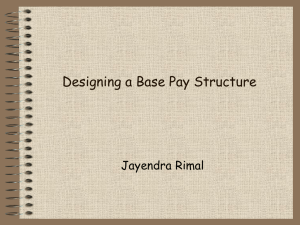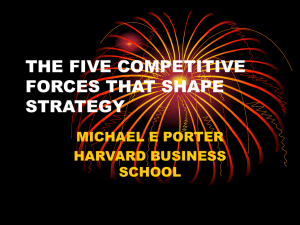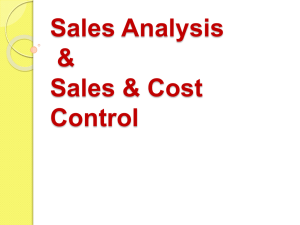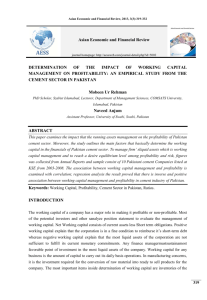Profitability modeling enables supply chain opportunities
advertisement
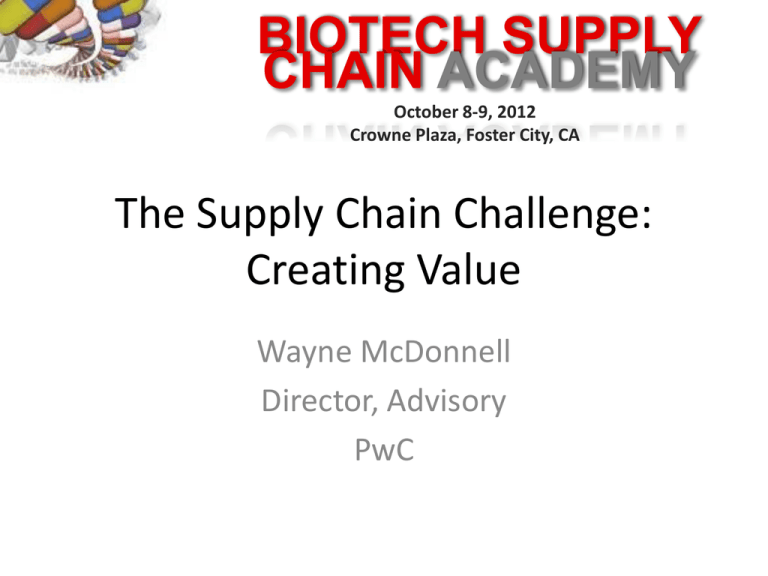
BIOTECH SUPPLY CHAIN ACADEMY October 8-9, 2012 Crowne Plaza, Foster City, CA The Supply Chain Challenge: Creating Value Wayne McDonnell Director, Advisory PwC Preparing for the “New Normal” In an era of increased change and unanticipated events, volatility is becoming the “new normal” Shifting Global Demand Growth 2x 32% Higher GDP growth in AP, MEA vs EUR, NA* of CEOs are “extremely concerned” about volatility* 66% of CEOs say that uncertain growth influences their strategy* Volatility and Uncertainty * PwC 15th Annual Global CEO Survey (2011) 4/13/2015 Continued Cost Pressure 66% Operations Management Challenges >60% of CEOs expect to implement cost reduction initiatives, an increase over 2010 survey* of operations executives named supply assurance and flexible supply chain architectures as top priorities** End-to-End Value Chain Flexibility ** 2011 PRTM Global Supply Chain Trends Study 2 Emerging from the “Save” Mentality Companies can realize the strategic advantage of a robust supply chain by modifying the ‘old’ view of its capabilities Resiliency Cost Containment Risk Avoidance 4/13/2015 Agility Companies are shifting from the ‘save’ mentality to seeing the effects a robust and flexible supply chain has on top line growth and bottom line value Integration Flexibility & Segmentation 3 How do we create value? Supply Chain Strategy and Capabilities 4/13/2015 4 Six key elements of an end to end supply chain planning process . Organization and Decision Making 1 • • • • Sales and Operations Planning Process 3 Metrics 2 Executive staff NPI / Operations / SC Sales and marketing Finance Step 1 Demand • • • • Step 3 Demand / Supply Balancing Planning Step 2 Supply Planning Business Assumptions 4 • • • • Key market trends Product roadmap Pricing and promotion plans Financial targets 4/13/2015 Inventory turns On-time delivery Cycle time Forecast accuracy Step 4 Implementation Demand Plan Step 4 Implementation Supply Plan 5 Planning Calendar • Cross-functional responsibilities • Daily/weekly activities • Weekly//monthly/quarterly approval meetings 6 Systems and Tools • Automated demand and supply plan generation with allocations • End-to-end supply chain inventory visibility 5 Understanding Segmentation Customer & Market Analytics Current Capability Assessment Govern & Refine Seven Step Process Align Crossfunctional Metrics & Incentives Align & Enable Dynamic Cost Model 4/13/2015 Cluster Value Chain Requirements Design Portfolio of Supply Chains 6 The Power of Supply Chain Segmentation Supply chain leaders know how to created differentiated supply responses to various demands…and create / deliver value Grouping Planning Benefits High A A Volume High B I. C A B Volume Volume II. B C III. C Event/ Promotions Low Low Low/Constant High/Erratic Consumption Variability NPI/ EOL Forecast Accuracy Safety Stock 4/13/2015 7 The Power of Supply Chain Segmentation Increasing forecast accuracy and reducing forecast dependency is equally managed by supply chain leaders Smallest Return on Investment A demand driven, near real-time supply chain successfully optimizes inventory and manages other costs related forecasting error SC Planning Practices Forecast Accuracy and Process Improvement Differentiated End-to-end Supply Chain Model SC Planning Processes and Systems Highest Return on Investment Reduce Dependency on the Forecast Supply Chain/ Performance Impact Strategic Options Deploy processes to increase forecast accuracy -andOptimize Safety Stock Co-planning NPI / EOL Event/ Promotion Process Reduce Forecast / SC Planning Dependency Seasonality Statistic Safety Stock 4/13/2015 Aggressive Lead Time Reduction Optimal Safety Stock Postpone Differentiation MTO Deploy strategies to reduce forecast dependency whenever possible 8 Understanding Net Profitability Profitability modeling enables fully loaded net margin visibility and provides new insight into the drivers of financial performance Worst: Managing primarily by Gross Margin • Slightly Better: Managing primarily by Contribution Margin Best: Managing by primarily by Net Margin • • • • • • • • 4/13/2015 Ignores substantial costs to serve Justifies unprofitable business Leads to business complexity ILLUSTRATIVE Customers that Gross Margin suggests are the “best” often become the “worst” when all cost are included Includes only direct variable costs Excludes substantial costs that should be managed as variable but typically are not (overhead, SGA, etc.) Includes all costs of business Clarifies profit contributing and non-contributing customers, products, channels, etc. Leads to better management and higher performance 9 Enterprise Profit Realization (EPR) EPR is based on achieving dramatic improvements in customer lifecycle, product lifecycle, and supply chain management Customer Life Cycle Mgmt • Customer portfolio rationalization • Sales force effectiveness • Pricing strategy • Customer profitability by segment and channel • Account management • Sales OpEx • CLC process improvement and tools Supply Chain Mgmt • Sourcing improvement • Manufacturing process improvement • Distribution network optimization • Inventory management • Freight cost reduction • SLA s reflect cost to serve • Supply Chain OPEX 4/13/2015 Enterprise Profitability Realization Framework Corporate/BU Vision, Mission, Values and Strategy Customer Lifecycle Management Product Lifecycle Management Profitability Modeling & Measurement Supply Chain Management Product Life Cycle Mgmt • Product line rationalization • Marketing and technology investment return/ affordability • Price Setting and Administration • Product line profitability by segment • Portfolio management • Marketing OpEx • PLC process improvement and tools Profitability Modeling Profitability Modeling is the critical enabler to moving to best in class. Factoring in fully loaded costs and fully allocated discounts and revenue offsets at a transaction level is critical. It enables transparency into true customer and product profitability and enables fact-based decision making using new Performance Metrics Delivery Model 10 Profitability Opportunities Five typical issues that are usually not addressed by traditional cost-cutting and restructuring initiatives; KEY is understanding Gross to Net Value Levers 1 • Increase price/reduce discounts • Change pricing/revenue model Improve Gross Profit Increase Revenue • Increase sales volume 2 • Change product mix • Unbundle product/service offerings • Change customer mix/Optimize portfolio Decrease COGS • Reduce costs of supplies • Change product mix Reduce Selling/ Marketing Costs Economic Profit Decrease SG&A • Increase Sales Force productivity • Decrease staffing • Consolidate/Optimize marketing/Media spend • Optimize physical network Reduce Distribution Costs • Optimize scheduling • Leverage alternative distributions Increase Capital Efficiency • Lower customer service costs • Lower IT costs • Lower HR costs • Reduce inventories Improve Cost of Capital Large customers do not always equate to profitable customers 5 to sell products, not target profitable customers Many Marketing/Media Initiatives result in low or negative ROI • Reduce AR/Increase AP • Improve capital planning process 4/13/2015 Large number of products have low sales and serve low or unprofitable customers 4 Sales force is structured • Consolidate transportation vendors • Decrease staffing Reduce Admin. Costs 3 Price is the largest contributor to NOI improvement, but rarely used • Reduce cost of Debt • Reduce cost of Equity • Adjust Debt/Equity Mix Excess inventories due to customer/ product inefficiencies 11 Supply Chain Opportunities Profitability modeling enables supply chain opportunities assessment on five key supply chain areas; performed based on benchmarking ILLUSTRATIVE Plan Processes that balance aggregate demand and supply to develop a course of action which best meets sourcing, production and delivery requirements Source Processes that procure goods and services to meet planned or actual demand Make Deliver Return Processes that transform product to a finished state to meet planned or actual demand Processes that provide finished goods and services to meet planned or actual demand, typically including order management, transportation management, and distribution management Processes associated with returning or receiving returned products for any reason. These processes extend into postdelivery customer support • Production Scheduling • Manufacturing • Assembly • Kitting • Warehousing • Distribution • Outbound Transportation • Reverse Logistics Functional Processes • Demand Planning • Inventory Forecasting 4/13/2015 • Sourcing • Procurement • Inbound Transportation • Inventory Management 12 Improving Profitability Start with 360 degree profitability view of the enterprise, then rationalize customers and products, and optimize operations and supply chain Develop Profitability Model Create end-to-end financial picture of the enterprise Customers Rationalize Customer Portfolio Rationalize Product Portfolio Optimize Operations Exit unprofitable customers Sunset products that no longer sell Rationalize Sales and Supply Chain for less complex portfolio Shift low profitable customers to distributors Rationalize low performing products to tier 2 or 3 customers Align sales to more profitable customers/products Customers Customers Products Products Customers Products Products Sales Sales Sales Sales Supply Chain Supply Chain Supply Chain Supply Chain 4/13/2015 13 Thank You! We create client value by building the critical link between strategy and execution…what is your strategy? Driving Strategy to Execution Business Strategy Execution Operations Critical Link Business Design and Operational Strategy Organisation Design and Change Management End-to-end Capabilities Strategy Customer Product Innovation Operations People and Change Finance Technology Risk Deals 4/13/2015 14
